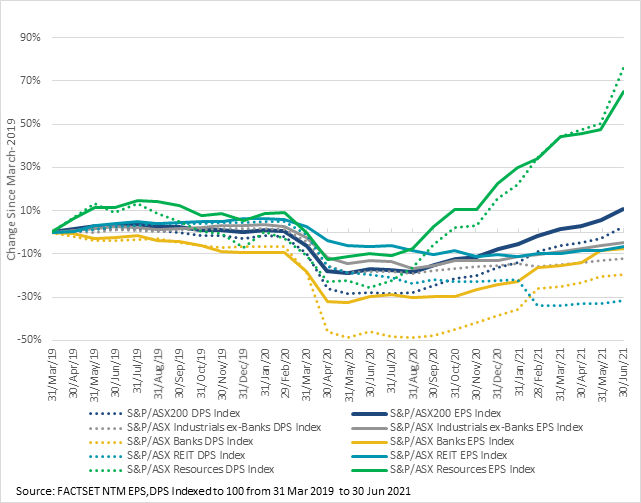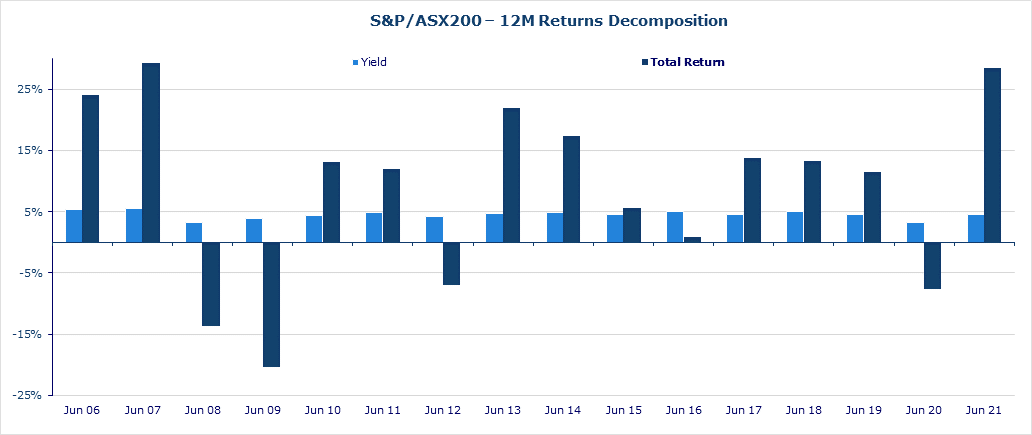Good news: Signs of stronger dividend payouts on the horizon
Livewire recently spoke with Michael Maughan from Tyndall AM, who co-manages the Nikko AM Australian Share Income Fund* to see what the upcoming reporting season is expected to bring and whether income investors are in for some headwinds. He also talked about the challenge investors face in today’s environment in finding income opportunities and his belief that equities are still the best place to create income today, and capital growth for tomorrow.
The outlook for dividends: Dividend decline and recovery
Last year was a wild ride for dividends. Dividend expectations fell from pre-COVID levels by about 30%. Some sectors have managed to recover better than others, but overall dividends are back to 2019 levels.
"All we knew was that boards would be conservative in the short term, and that's how it played out," said Maughan.
Earnings vs dividend – consensus estimate paths (March 2019 – June 2021 -1/+1 COVID-19)

The February reporting season saw dividend recovery in some sectors, while others were left behind. Source: Tyndall AM
"We're back now above pre-COVID expectations on dividends. But underlying that is resources dividends that are 60% higher than they were pre-COVID, with Bellwether sectors, like banks, still being 20% below what they were," said Maughan.
But Maughan thinks that it will be a quick recovery for the banks, which were dealing with COVID-19 impacts compounded by APRA restrictions on its capital requirements.
"We expect that bank payout ratios will return to around 70 to 80% payout ratios (just below their pre-COVID levels). But also, banks are going to be returning capital to shareholders because they are over-provisioned and over-capitalised. CBA and ANZ are sitting on a lot of excess capital, and they could announce buybacks any day now," said Maughan.
“The Australian market is a great place for investors looking for dividend income”, Maughan added, “delivering both income and growth”.
“We see tailwinds for dividends in low interest rates making them relatively attractive sources of income; normalising earnings and payout ratios delivering growth, and with markets at all-time highs dividends are likely to make up a larger part of returns in the next few years.”
“The need for income and capital growth is going to increase as people continue to live longer. Dividends give money to live off from consistent cash flow, but more importantly, they give that income in capital drawdown years so investors don’t have to lock in losses,” says Maughan.

Source: Datastream, CLSA
Maughan is cautious that recent lockdowns could dim the reporting season ahead and throw out a few "surprises" to the outlook for FY22.
Who will be the other big dividend players this reporting season?
There are a few sectors that Maughan is keeping an eye on, such as insurance, which he said has a strong environment for premiums ahead and, those bedding down recent M&A activity, such as IOOF.
"We'd be looking for news from companies like IOOF, where they can show progress on their acquisitions of ANZ and MLC, to give the market confidence that that's all on track," he said.
Maughan also believes several of the major Aussie dividend payers will announce buybacks or special dividends with their results, including CBA, BHP, Rio Tinto, Woolworths, and Telstra.
Telstra is his standout for a dividend stock with tailwinds.
"I think one traditional yield stock that's been out of favour has been Telstra, and we see its fortunes turning," said Maughan.
"The key here is the mobile business which has returned to growth as they launch their 5G services ... And that should drive earnings growth at the group level for the next couple of years," he said.
"Helped by the fact that we're past the drag of the NBN rollout," he added.
What to watch out for: inflation
Inflation is still the word on everyone's lips (read: Twitter) and could hit income stocks once interest rates go up. But Maughan doesn’t think we’re quite there yet.
"I think the first issue is that right now bond yields are around 1 to 2%, making dividends a very attractive source of income. The ASX 200 is forecast to generate a grossed-up dividend yield of about 5% in FY22. We aim to continue a 12-year track record of delivering 2% higher than that," he said.
"Equities still look like a great source of income for investors even if the yield curve steepens from here.”
"Where rates might be more relevant is in sector allocation within equities. I would be worried about rates if I had all my dividend exposure in bond proxy-type companies like REITs and infrastructure stocks. We're big believers in having diversified portfolios for generating this income," said Maughan.
Diversification: the name of the game
Given the need for people to source income and capital growth in the current environment to fund their retirement, Maughan explains how he and his co-portfolio manager Mal Whitten, create a diversified portfolio to achieve income and capital growth for investors.
He stresses the need for active management in achieving income goals, and for investors to understand that not all income funds are created equal.
“The first thing an income fund should do is commit to prioritizing Income, not income style stocks, but an income objective to be measured against. You would be amazed how many income funds don’t promise a yield or only offer “a yield higher than the market” commitment,” he said.
“ An investor is unlikely to have the time or resources to constantly re-assess the sustainability of dividends from salmon farming whilst also deciding whether an iron ore royalty stream is a better investment than the miner of that iron ore. We look across the whole market because we have a team of 11 including former engineers, geologists, and actuaries who can take a view on a wide range of companies that will allow you to spread the risk rather than get caught in the same old yield sectors with the same types of risks in them,“ said Maughan.
Recognising dividend traps
Maughan explains how they monitor and manage risk with the help of quant analysis and discussed how they avoid dividend traps at a portfolio level.
“We have learned over the years, sometimes the hard way, to avoid both types of dividend traps,“ he said.
“The first trap is the structurally challenged company that will never get back to its former glory because the industry has changed, or the franchise has lost its competitive advantage. Think traditional media companies in the last 10 years,” said Maughan.
“The second type of dividend traps are cyclical companies that have peaked but still pay good dividends... until they don’t. Think BHP and RIO in 2015/16 when the dividends were still strong—partly thanks to idiotic progressive dividend policies—but also the iron ore price had been going down for 2 years,” Maughan added.
Maughan explains how the team applies an intrinsic value process to protect and grow capital.
“Dividend yield alone is a terrible measure of value and it is the combination of yield with our proprietary value signals that changes it from a way to destroy value, to a reliable investment. Anyone can manufacture a yield by stealing it from capital. To prove that we’re not doing that we expect to be judged on whether we delivered a market return, or better, over the long term, whilst delivering the primary yield objective,” he said.
“This discipline is especially evident in off-market buybacks. They can be great opportunities and we participate in many but will not just take the easy yield unless we think it is the best thing from an overall after-tax total return perspective.” Maughan added.
There is a common view that income funds are a set-and-forget portfolio. Maughan explains that’s a misconception.
“Nothing could be further from the truth. We are constantly managing around ex-dividend dates and 45-day rules because your investor needs to own the stock at the right time to get the dividend. We are also taking advantage of takeovers and buybacks where franking credits are undervalued,” he said.
“Of course, the main aspect of being active is to follow the value opportunities as they move around the market. The reality is that portfolios are living things. We're always balancing the dual objectives of delivering income while protecting and growing capital," Maughan concludes.
A front-row seat to income and growth
Michael invests in 40-70 stocks, designed to provide tax-effective income and the potential for capital growth. To learn more, click here.
*Nikko Asset Management Australia was acquired by Yarra Capital Management in April 2021. The Nikko AM Australian equity funds will be rebranded as Tyndall AM in due course.
1 contributor mentioned


